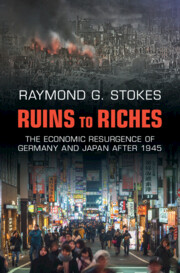Book contents
- Ruins to Riches
- Ruins to Riches
- Copyright page
- Dedication
- Contents
- Charts and Figures
- Acknowledgements
- Introduction
- Part I No Mere Incantation
- Part II Making Miracles, 1950–1973
- 3 Manufacturing Miracles I
- 4 Manufacturing Miracles II
- 5 Consuming Miracles
- 6 Exporting Wonders
- Part III Sustaining Miracles, 1973–1989
- Part IV Navigating Waves of Globalization, 1990 to the Present
- Notes
- Index
6 - Exporting Wonders
from Part II - Making Miracles, 1950–1973
Published online by Cambridge University Press: 12 April 2024
- Ruins to Riches
- Ruins to Riches
- Copyright page
- Dedication
- Contents
- Charts and Figures
- Acknowledgements
- Introduction
- Part I No Mere Incantation
- Part II Making Miracles, 1950–1973
- 3 Manufacturing Miracles I
- 4 Manufacturing Miracles II
- 5 Consuming Miracles
- 6 Exporting Wonders
- Part III Sustaining Miracles, 1973–1989
- Part IV Navigating Waves of Globalization, 1990 to the Present
- Notes
- Index
Summary
West Germans and the Japanese became increasingly proficient during the first quarter-century after 1945 at manufacturing things and selling them abroad. This translated by the 1970s into growing balance of trade surpluses with much of the rest of the world, especially the United States and UK. But there was a puzzle in terms of perceptions, in the United States in particular: US trade deficits with the two countries posed similar levels of political and economic risk. Yet, it was the Japanese who became the primary target of the wrath of the Americans because the US trade deficit with Japan by that time was larger than that with Germany, even though that diverted attention from a much more important problem, the loss of US manufacturing markets to German competition in third countries; Americans viewed the Japanese domestic market as far less open than Germany’s; and Japanese exports to the United States were highly visible. German exports tended to flow directly to manufacturers of other things, thus rendering them largely invisible. The growing prominence of Japanese products and names in highly visible sectors such as consumer electronics and motorcycles led to the conclusion that the Japanese were unfairly eroding American industrial dominance.
- Type
- Chapter
- Information
- Ruins to RichesThe Economic Resurgence of Germany and Japan after 1945, pp. 112 - 136Publisher: Cambridge University PressPrint publication year: 2024



